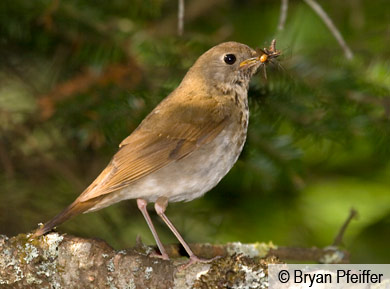A NEWS RELEASE from VCE – March 18, 2014
NORWICH, VT – A rare songbird that breeds in the U.S. and Canada faces profound threats from illegal farming on its wintering grounds in the Dominican Republic, according to scientists and conservationists who recently documented farms in one of the country’s premier national parks.
Commercial avocado plantations and subsistence farms in the high-elevation cloud forests of Sierra de Bahoruco National Park are degrading or eliminating forest habitat for the migratory Bicknell’s Thrush, which is already being considered for protection under the U.S. Endangered Species Act.
“A national park is the last place we would expect to discover an ecological crisis like this,” said Chris Rimmer, executive director of the Vermont Center for Ecostudies and a leading researcher on Bicknell’s Thrush across its migratory range. “Our work protecting this songbird where it breeds here in the U.S. and Canada will be for naught if we can’t conserve wintering habitat in the Caribbean.”
Agriculture inside the park has come to light in a new report from Grupo Jaragua, a non-governmental conservation organization based in the Dominican Republic. Rimmer and Grupo Jaragua’s president, Yolanda León, explored the park’s affected areas in mid-February, after which they met with Dominican Republic Ministry of Environment officials to seek constructive solutions for protecting the thrush’s dwindling forest habitat.
“We were shocked to discover such widespread destruction inside the park’s boundaries,” said León. “We hope this report and our recent discussions with Dominican Ministry officials bring increased attention to this serious problem, so we can find an effective, collaborative solution and preserve what little is left of these irreplaceable forests.”
Brown and speckled with a fluty song, Bicknell’s Thrush nests in scattered high-mountain and coastal forest sites in eastern Canada and the northeastern U.S. Its wintering range is limited to remote forests of Hispaniola and three adjacent islands in the Caribbean Basin. The songbird’s small worldwide population and fragmented distribution compound its vulnerability to climate change, toxic mercury contamination and habitat loss in North America.
A coalition of U.S. conservation and science groups, concerned about forest loss in the thrush’s Caribbean wintering areas, took the innovative step in 2012 to award a grant for Grupo Jaragua’s investigation in and near the southern sections of the national park.
The rugged and remote protected area in Sierra de Bahoruco harbors an extraordinary array of unique flora and fauna. Grupo Jaragua’s 55-page report concludes that vast areas of southern Sierra de Bahoruco, including portions well within the national park, have been deforested to make way for three forms of agriculture:
- Industrial Avocado Plantations – These large plots often grow the Haas variety (with dark, bumpy skin) suitable for export. Haitians, hired as permanent or seasonal workers by Dominicans who have appropriated the land, live on the plantations in rudimentary shacks, and are sometimes encouraged to cut nearby forested areas for subsistence farms.
- Subsistence Agriculture – This is a form of sharecropping between both Haitians and Dominicans, who grow beans, corn, local pumpkins, yams, carrots and other crops. This system is widely implemented throughout the southern slopes of Bahoruco National Park, Grupo Jaragua’s report said.
- Coffee Plantations – These farms appear to have operated under similar sharecropping arrangements with Haitian tenants. Recently, however, some plantations have been abandoned or converted to subsistence agriculture, perhaps owing to coffee pests and low market prices for coffee.
“In some areas, even where part of the original forest is still standing, it is slowly being degraded by different persons entering to take wood for cooking, making charcoal, removing beams for construction, etc.,” the report said. “Cows also often graze and pigs enter these areas to forage, affecting forest dynamics and natural restoration.”
The Dominican Republic supports the world’s most vital wintering habitats for Bicknell’s Thrush, said Rimmer, who has been conducting research in the country and adjacent Haiti for two decades. Grupo Jaragua and its conservation partners in the Dominican Republic and North America fear that agricultural expansion and charcoal production threaten habitat in northern portions of the Sierra de Bahoruco as well.
With a world population estimated at 100,000 or fewer individuals, which is precariously low for a migratory songbird, Bicknell’s Thrush has galvanized a corps of scientists and conservation organizations to work on its behalf.
The International Bicknell’s Thrush Conservation Group (IBTCG) is an alliance of scientists, natural resource managers, and conservation planners advancing the study and conservation of Bicknell’s Thrush through science and international cooperation. In 2010, IBTCG issued a conservation plan for the songbird that recognizes the need to work across its entire range. The report, in both English and Spanish, is available at: http://www.bicknellsthrush.org/conservation.html.

